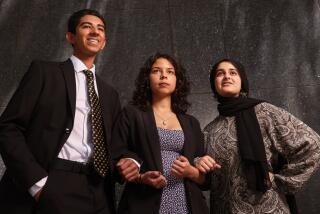Study Aims to Aid Children With Asthma
SANTA ANA — The three Molson children have had asthma since they were babies. They know that an attack--a wheezing episode that leaves them gasping for breath--could be just around the corner, or in the next room, if it is filled with perfume or smoke. Their mother lugs around a rumpled paper bag full of medicines and inhalers wherever her brood goes.
Even at home, the kids routinely wear paper masks over their mouths and noses when housecleaning must be done, and they sleep with plastic covers over their pillows to keep dust and irritants at a minimum.
The Costa Mesa family, including Wannessa, 12, Braendey, 10, and Gretzkhey, 9, is participating in a national study to determine whether educational sessions can help control the lung disease among children in urban areas, where it is worst.
Asthma, a chronic respiratory disease involving hyper-reactive and inflamed bronchial tubes that narrow during attacks, is the leading serious chronic illness in children, according to the American Lung Assn. It affects more than 170,000 children in Los Angeles County and nationally accounts for 10 million missed days of school a year.
While many asthma attacks can be prevented or controlled, the disease can be life-threatening if not properly managed.
As part of the study, underway in five cities, 35 severely asthmatic children and their parents will attend eight two-hour sessions in Santa Ana designed to help educate the families not only about the disease but about communicating. If children and parents learn to speak up about triggers, such as food and dust, they can manage the disease better wherever they are, authorities say. For example, the sessions include how to deal with landlords about problems with carpet fibers or cockroach infestations.
After the sessions end, researchers will compare the number of emergency hospitalizations among the children in the program to those of similar children, said Dr. Sherwin Gillman, an allergist and volunteer with the Orange County office of the Lung Assn.
The same program is underway in Ventura, Dayton, Ohio, Cincinnati, and Minneapolis, Minn. The data from all five sites will be compared.
If the study shows that the sessions reduce the number of asthma attacks, “what we’d like to do is expand it on a national level,” Gillman said.
The program targets urban areas because asthma is known to be worse in densely populated communities for several reasons. Commercial buildings in urban areas increasingly are being designed with sealed windows that do not allow fresh air to disperse indoor irritants; the air in urban areas also is bad. And studies have linked higher ozone and airborne particulate levels, elements of smog, to increased asthma attacks.
Urban areas also have more child-care facilities, which expose children with respiratory ailments to more infections, Gillman said.
Housing in crowded communities is more likely to have dust mites and cockroaches, which leave behind droppings and other debris that can produce allergic reactions.
In poor urban areas, fewer people have medical insurance and they are less likely to see a doctor unless it is an emergency, he said. And in some ethnic cultures, people rely on “folk and home remedies and the advice of people without the right information,” Gillman said.
The rate of asthma among Latino children is 2 1/2 times greater than among white children, probably because so many Latinos live in urban areas, according to the Lung Assn. For that reason, the Orange County chapter is offering the educational sessions in English and Spanish.
At each study site, children list their personal triggers, which differ from child to child. In the Molson household, the list includes pork, beans and broccoli, grass, smoke, dust, feathers and perfume.
Although asthma has not stopped the Molson children from participating in sports at school, Wannessa remembers an attack coming on when she was running track.
“It felt like everything was tightening up. I was getting dizzy, and I slowed down. But I came in seventh,” she said. She did not tell her coach, she said--for fear she would not be allowed to run--but quietly went to her locker to use her inhaler.
Braendey and Wannessa tell few friends about their asthma because they do not like to be considered different. Gretzkhey, however, wants his friends to know “because I have it and they don’t.”
In the Lung Assn. program, the children meet others with the disease and feel less odd, said Joy Reynolds, a volunteer and an asthma patient. The kids exchange information and tips on how to deal with social situations, and how to cope at school when things happen that might trigger their allergies.
“It’s about getting families and the kids to talk about it,” Reynolds said, “and helping the children get more in control, even when they are not with their parents, when they are at school, or at their friends’ houses.”
Erica Sullivan, the program director, said one girl became teary during a recent session as she described her attacks. It was the first time her mother had heard her express fears about the disease.
“It wasn’t something they ever talked about before,” Sullivan said.
(BEGIN TEXT OF INFOBOX / INFOGRAPHIC)
Breathing Lessons
From 1992 to 1996, the estimated number of Orange County children with asthma increased 43%. Classes are underway to help educate asthmatic children and their families. Estimated number of cases:
‘96: 48,516
Source: American Lung Assn.
More to Read
Sign up for Essential California
The most important California stories and recommendations in your inbox every morning.
You may occasionally receive promotional content from the Los Angeles Times.









